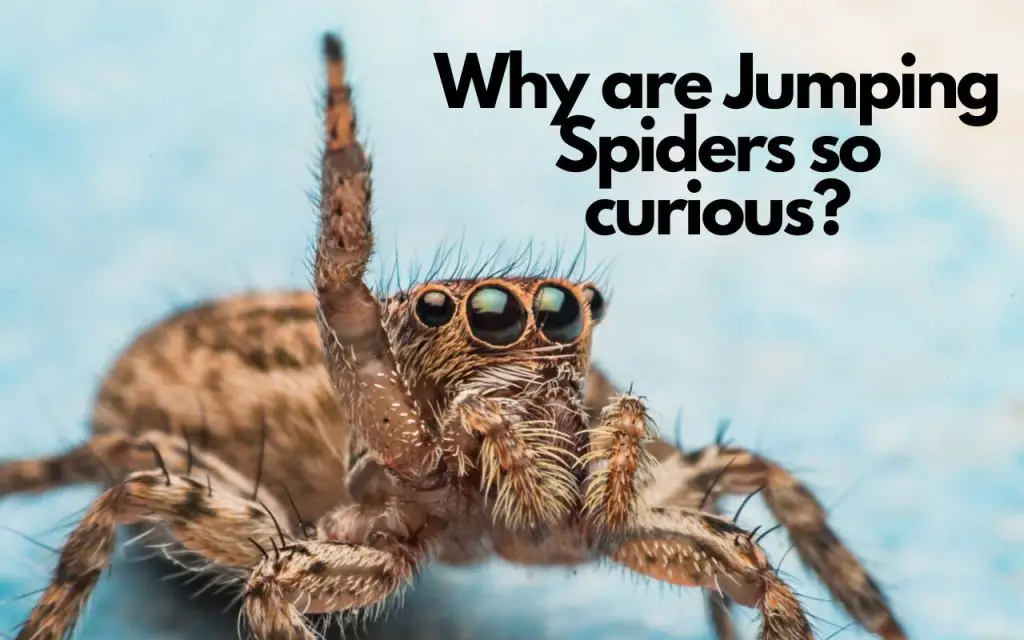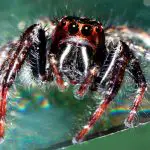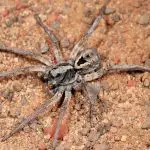As you might of guessed, the reason I take the time to write so many posts on Jumping Spiders is that they are so popular. The reason for this is simple: They are probably the most interactive pet arachnids out there. If you keep one as a pet, you’ll soon notice it watching you, and it may even want to come out of its enclosure to meet you. This prompts the question: Why are jumping spiders so curious?
In this article, we’ll discuss how intelligence and curiosity are in fact vital to the survival of Jumping Spides. Let’s jump in…
Cursorial Hunters That Use Saltation (Jumping!)
First and foremost, we have to understand what makes jumping spiders different from their other eight-legged cousins.
Jumping spiders, part of the family Salticidae, are among the most athletic of spiders. Unlike most spiders that rely on webs to catch their prey, jumping spiders use a hunting style called saltation, meaning they leap onto their prey.
How they do this is a marvel of natural engineering. Jumping spiders have a special hydraulic system in their legs. By changing the pressure of the fluids in their bodies, they can jump many times their own body length with uncanny precision. It’s this active hunting style that necessitates a certain level of curiosity – a trait that makes these spiders stand out.
How Intelligence and Curiosity Help with Hunting
To successfully leap onto their prey, jumping spiders need more than just power; they need brains. They have to calculate distance, angle, and even account for the potential movement of their prey. That’s why jumping spiders are considered among the most intelligent of spiders.
Jumping spiders display a level of problem-solving ability that’s rare in invertebrates. They are known to learn from their mistakes, changing their strategies if their initial attack fails. This inherent curiosity allows them to explore their environment, learn about potential threats and food sources, and survive in a variety of habitats.
Do Jumping Spiders Remember You?
This is a question I get asked a lot, and it’s a fascinating one. Research suggests that jumping spiders can indeed remember certain aspects of their environment, and can even recognize individuals.
They can learn from their experiences, and recent studies have shown that they can retain these memories for an extended period. This capacity for memory may extend to recognizing humans, although the extent of this is still a topic of research.
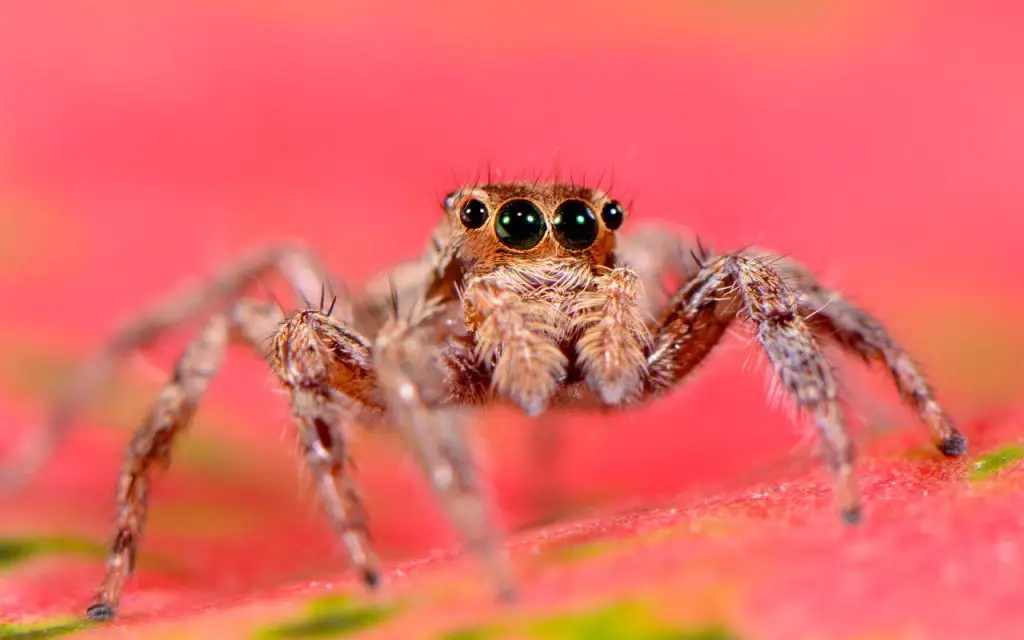
Why Do Jumping Spiders Wave?
Have you ever seen a jumping spider wave its front legs or its pedipalps (short appendages near the mouth)? This behavior is part of their complex mating rituals. Males will perform a ‘dance’ to attract females, which includes waving, drumming, and even some fancy footwork!
However, waving isn’t just for courtship. Jumping spiders also wave their legs to appear larger to potential predators, and in some cases, to communicate with each other.
It’s entirely possible that when your jumping spider ‘waves’ at you, or touches your finger, it’s trying to touch base, and say: “hey, I’m here – don’t squash me!”
Why Are Jumping Spiders So Friendly?
Something that you’ll notice when you encounter these arachnids is that they are not aggressive. It just isn’t in their nature.
Unlike many spiders, jumping spiders don’t generally see humans as a threat. This might give them the appearance of being ‘friendly’. Their inquisitive nature means they’re likely to observe you just as you’re observing them. They might even hop onto your hand out of curiosity.
That being said, it’s important to remember that they are wild animals. While they’re not dangerous to humans, they should always be handled with care and respect.
Are Jumping Spiders Smart?
As we’ve seen, jumping spiders display a remarkable level of intelligence for their size. They have excellent vision, with four pairs of eyes that allow them to see in almost all directions. This, combined with their problem-solving abilities and memory retention, makes them surprisingly intelligent hunters.
Do Spiders Jump at You?
While jumping spiders can, well, jump, they’re not likely to jump at humans unless they feel threatened. Even then, it’s more likely they’ll try to run (or jump) away rather than towards you. As always, it’s best to observe wildlife with respect and caution.
In the unlikely event that a jumping spider jumps onto you, the most likely reason is that it things you’d be a good surface to hunt flies on!
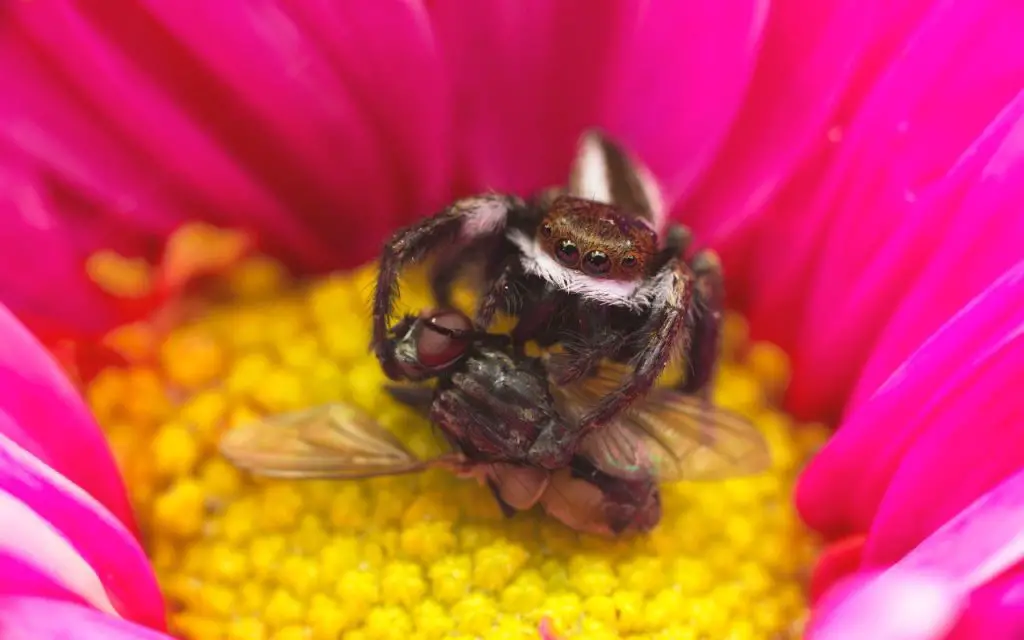
10 Facts About Jumping Spiders
Now that we’ve dived deep into the behavior of these fascinating creatures, let’s take a quick look at some lesser-known facts about them:
- There are more than 5000 species of jumping spiders.
- They have the best vision among invertebrates.
- Their jump is a combination of muscle power and internal hydraulic pressure.
- Some species mimic ants to fool predators.
- They don’t use webs to catch prey.
- Female jumping spiders are often larger than males.
- Their lifespan typically ranges from 6 months to 3 years.
- They use silk safety lines while jumping to prevent falls.
- They can rotate their heads to look around.
- Some species change their color over the course of their lifetime, as is the case of Phidippus nikites, for example.
Are Jumping Spiders Good Pets?
This brings us to our final question: Can you keep a jumping spider as a pet? In fact, many people do. Jumping spiders can make fascinating pets for those interested in arachnids. They’re relatively easy to care for, requiring a small enclosure, a diet of insects, and a bit of daily misting for humidity.
However, like any pet, they require commitment and responsible care. They are not toys, but living creatures that deserve respect and proper treatment. If you’re considering getting a jumping spider as a pet, make sure to do your research and prepare to meet their needs.
| Pros of Keeping a Jumping Spider as a Pet | Cons of Keeping a Jumping Spider as a Pet |
|---|---|
| Easy to care for | Not a traditional pet |
| Fascinating behaviors to observe | Some people may find them scary |
| Requires minimal space | Lifespan is relatively short |
| Doesn’t make noise | Needs live food |
| Don’t need heating appliances | Great at escaping |
Why are Jumping Spiders so curious? Conclusion…
These spiders are so curious because it helps them survive. For cursorial hunters (which means on foot rather than in a web) curiosity means noticing movement that could indicate the presence of a tasty meal. It helps them get the jump on their prey – literally!
Jumping spiders are a testament to the marvels of evolution. They’re tiny creatures that have adapted in unique ways, developing intelligence, precision, and a charming curiosity. Whether you’re considering one as a pet or just watching them in your garden, I hope you’ve gained a new appreciation for these incredible arachnids!
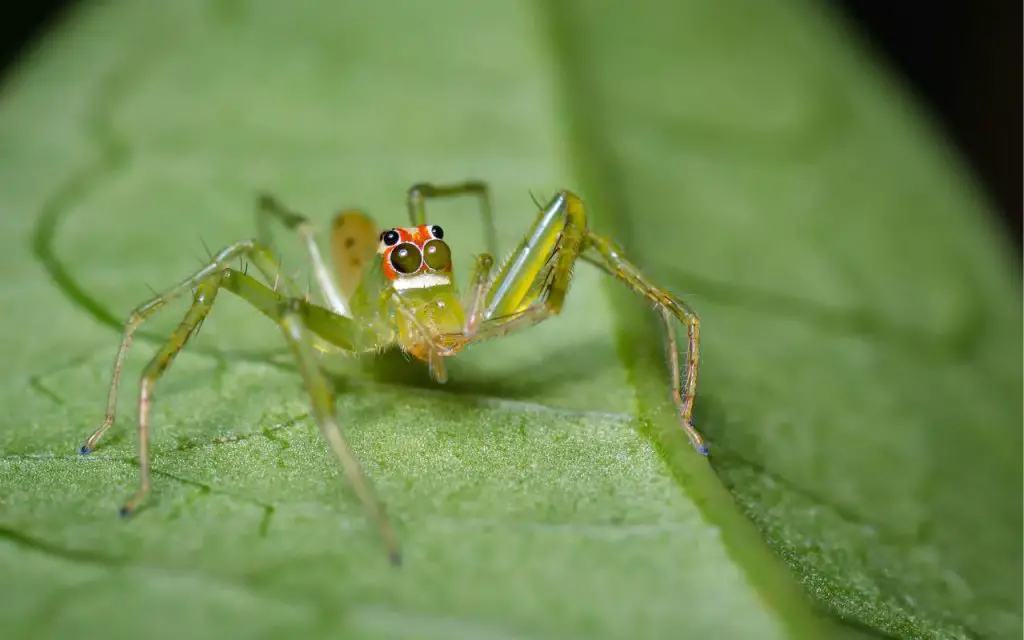
Why do jumping spiders seem intelligent?
The reason jumping spiders seem intelligent is because they genuinely are smarter than most other invertebrates. Using their keen eyesight and judging their leaps onto prey takes considerable computing power – something a lot of bugs just don’t have. Amongst spiders, jumpers are by far the smartest.
Do jumping spiders get curious?
Jumping spiders do get curious. You’ll notice them watching you and tracking your movements if you keep them, or observe them outdoors. Though it hasn’t been scientifically proven, it is entirely possible that they learn to expect food from you if you keep one. They also appear to enjoy coming out of their enclosures to explore.
Are jumping spiders highly intelligent?
Jumping spiders are highly intelligent when compared to other spiders, and most other invertebrates overall. Whilst ants are known for their intelligence, even they fall prey to jumping spiders.

